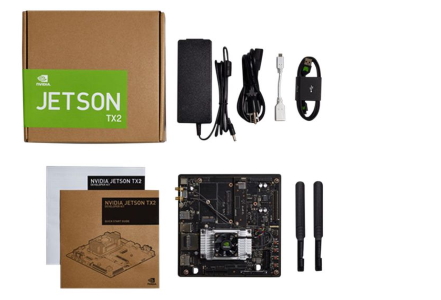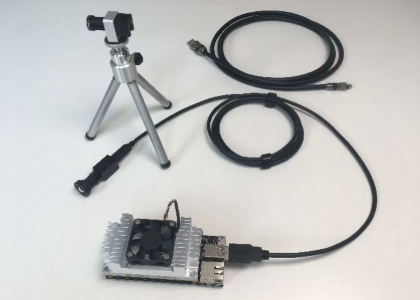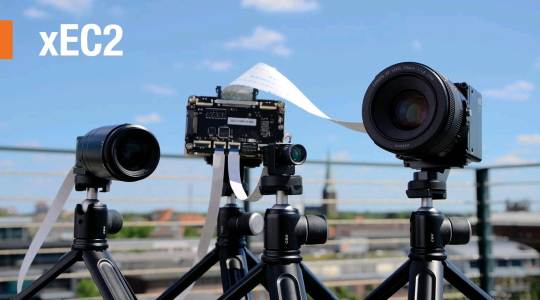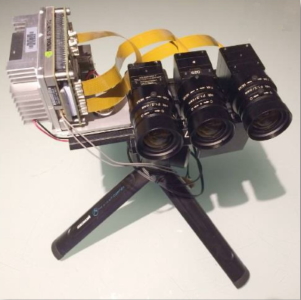NVIDIA Jetson TX2 Benchmarks¶
- NVIDIA Jetson TX2 Benchmarks

Fig.1. Jetson TX Developer Kit
The Jetson TX2 is one of the first GPU modules from NVIDIA which is still relevant due to several benefits to edge AI applications.
It is built around an NVIDIA Pascal™-family GPU and loaded with 8GB of memory and 59.7GB/s of memory bandwidth making it fast, power-efficient (7.5 Watt) embedded computing device.
The additional Developer Kit provides a fast way to test the device, but there are also various 3rd party carrier boards available.
This Dev kit supports NVIDIA Jetpack—a complete SDK that includes the BSP, libraries for deep learning, computer vision, GPU computing, multimedia processing, and much more.
While the Devkit is useful with various interfaces, design guides and is pre-flashed Linux, it was interesting to check other carrier boards as well.
Below you can see the results of connecting XIMEA cameras to TX2 using 3rd party carrier boards as well as XIMEA's own xEC2.
NVIDIA Jetson TX2 with USB3 cameras¶
Hardware components:
- Jetson TX2 module
- Auvidea J121 carrier - two full speed USB3 ports
- XIMEA MU181CR-ON cameras: 18 MP, 4896 x 3680, Color model with USB3 interface
- Remote host computer with NVIDIA GPU

MRTech CamViewer demo application¶
CamViewer is a demo application designed to acquire images from USB3/PCIe cameras connected to a computer and displaying them on the screen.
The application is used for demonstrations and internal purposes of MRTech SK.
Processing pipeline:
- Free run acquisition
- auto exposure
- auto white balance
- demosaicing 5x5
- rendering on a screen (60 Hz)
Results with single MU181 camera¶
| Resolution | Bit rate | Frame rate | G2G Latency |
| Full frame 4896 x 3680 | 8 bit | 22 Fps | 160 ms |
| 2x2 binning 2448 x 1842 | 8 bit | 60 Fps | 90 ms |
Results with two MU181 cameras¶
| Resolution | Bit rate | Frame rate | G2G Latency |
| Full frame 4896 x 3680 | 8 bit | 10 Fps | 190 ms |
| 2x2 binning 2448 x 1842 | 8 bit | 30 Fps | 100 ms |
Note: The values are for both cameras.
MRTech camchronicler application¶
Two XIMEA MU181CR-ON color cameras - Master-Slave configuration
Processing pipeline:
- Image acquisition
- 12-bit
- 2x2 binning on the sensor
- 2448 x 1840, 4.5MP resolution (after binning)
- auto exposure
- auto white balance
- demosaicing 5x5
- H.265 encoding, 8/10-bit
- ULTRAFAST encoder preset
- Recording to MicroSD card
Results with two master-slave connected cameras¶
| Resolution | Bit rate | Frame rate |
| 2448 x 1840, 4.5MP | 12 bit | 30 Fps |
Note: Values per each camera.

NVIDIA Jetson TX2 with PCIe cameras¶
Hardware components:
- Jetson TX2 module
- XIMEA xEC2 carrier
- MX031CG-SY XIMEA color cameras : 3.1 MP 2064 x 1544 with PCIe Gen2 x2 interface
- Up to seven PCIe and USB3 cameras can be connected
- Remote host computer with NVIDIA GPU - Desktop station and 144 Hz monitor as a receiving station.
MRTech dragonfly application¶
Dragonfly application was designed by MRTech SK to receive RAW images from one or more USB3/PCIe cameras and stream the processed images via the network to a remote computer.
The application can run on NVIDIA Jetson modules, embedded or desktop computers with NVIDIA GPU.
The application is currently being used in several projects in aerial, ground drones, on vehicles, as well as in medical devices.
Processing pipeline on Jetson:
- 8-bit acquisition
- auto exposure
- auto white balance
- demosaicing 5x5
- H.264 encoding
- RTSP streaming
Processing pipeline on the receiving station:
- receiving of the RTSP stream
- H.264 decoding
- rendering on a screen (144 Hz)

Results with two MX031 cameras¶
| Resolution | Bit rate | Frame rate | Processing time | G2G latency |
| Full frame 3.1 MP (2064 × 1544) | 8 bit | 60 Fps | 15 ms | < 60 ms (with 144 Hz monitor) |
Note: The values are for each camera.
Instructions on how to install MicroSD card into TX2 carrier board¶
1. Turn off the TX2 module and insert the MicroSD card into the dedicated slot of the xEC2 carrier board.
2. Next, format the MicroSD card.- After turning on the TX2, open a console window.
- Find the MicroSD card location by using: $ lsblk
It could be located at: /dev/mmcblk2 - format the MicroSD card via: $sudo mkfs.ext4 /dev/mmcblk2
- Open "search your computer" icon.
- Type in "disks" in the searching text box, then double click the disks icon.
- Choose the "SD card Reader" in the left column, you will see where your card is mounted.
It could be mounted at: /media/nvidia/c51966bf-blabla